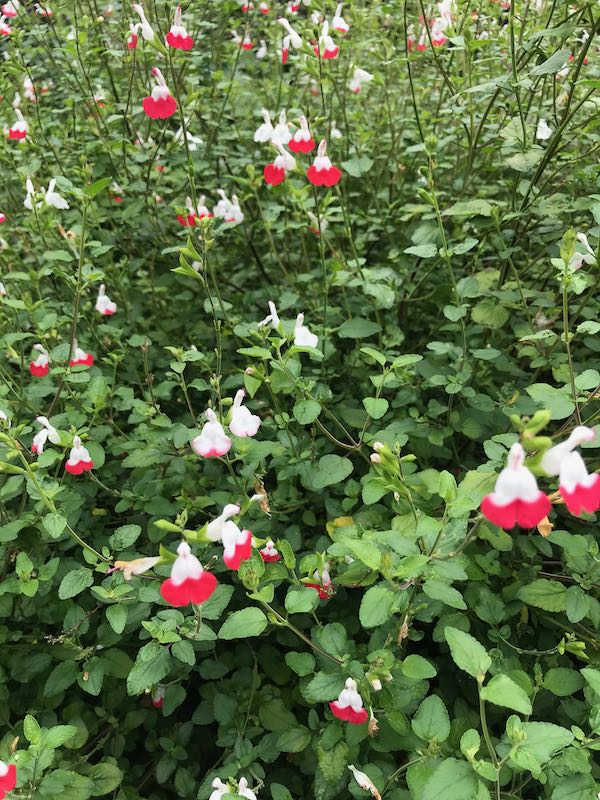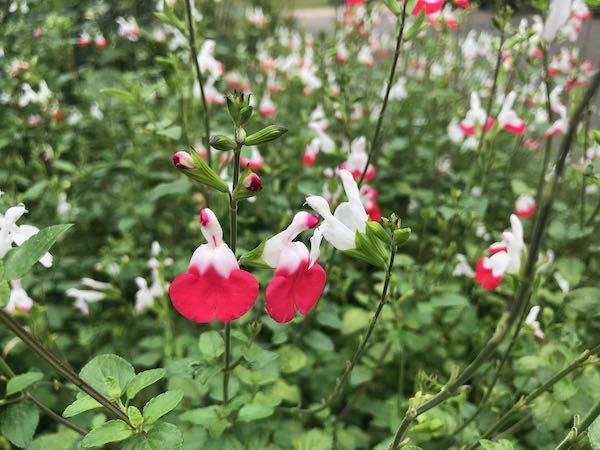Salvia microphylla ‘Hot Lips’ is part of the Lamiaceae family of plants. It is an evergreen perennial. They also call it the Baby Sage ‘Hot Lips’, Graham’s Sage ‘Hot Lips’, Blackcurrant Sage ‘Hot Lips’, Sage ‘Hot Lips’, Salvia ‘Hot Lips‘, or Salvia x jamensis ‘Hot Lips’.
Salvia microphylla ‘Hot Lips’ flowers from summer into autumn. The flowers are bicolored, white, and red. They grow on terminal racemes. They usually start as red in early summer, change to red and white in mid-summer, and then white in autumn. The foliage is ovate and green. It has aromatic leaves. It grows to 90cm or 3ft tall.

How to grow Salvia microphylla ‘Hot Lips’:
Salvia microphylla ‘Hot Lips’ is a delightful variety of Salvia that deserves a place in any garden. Here are some detailed care instructions to help you successfully grow and enjoy this beautiful plant:
Light Requirements: Salvia microphylla ‘Hot Lips’ thrives in full sun. While it can tolerate partial shade, it produces more flowers when exposed to abundant sunlight.
Soil Conditions: Plant Salvia microphylla ‘Hot Lips’ in moderately fertile soil that is well-drained and moist. Good drainage is particularly important to prevent waterlogging, which can lead to root rot.
Watering: Once established, ‘Hot Lips’ is relatively drought-tolerant. However, regular watering is necessary during hot and dry periods to keep the soil moist. Avoid overwatering, as it can lead to root problems.
Attracting Wildlife: One of the highlights of Salvia microphylla ‘Hot Lips’ is its ability to attract butterflies and hummingbirds to your garden. The vibrant flowers serve as a valuable nectar source for these pollinators.
Deer and Rabbit Resistance: ‘Hot Lips’ is known for its resistance to deer and rabbits. This makes it an excellent choice for gardens where these animals may pose a threat to other plants.
Propagation Methods:
You can propagate Salvia microphylla ‘Hot Lips’ through various methods. Basal cuttings, which involve taking young shoots from the base of the plant, can be rooted in a suitable growing medium. Softwood cuttings, taken from the current season’s growth, are another effective propagation method. Additionally, hardwood cuttings can be taken during the dormant season.
Disease and Pest Resistance: Salvia microphylla ‘Hot Lips’ is generally resistant to common diseases and pests. However, it is still important to monitor the plant for any signs of issues such as powdery mildew or aphid infestations. Promptly addressing any problems will help ensure the plant’s overall health.
By providing Salvia microphylla ‘Hot Lips’ with the right growing conditions and proper care, you can enjoy its abundant and captivating flowers while attracting beneficial wildlife to your garden.




